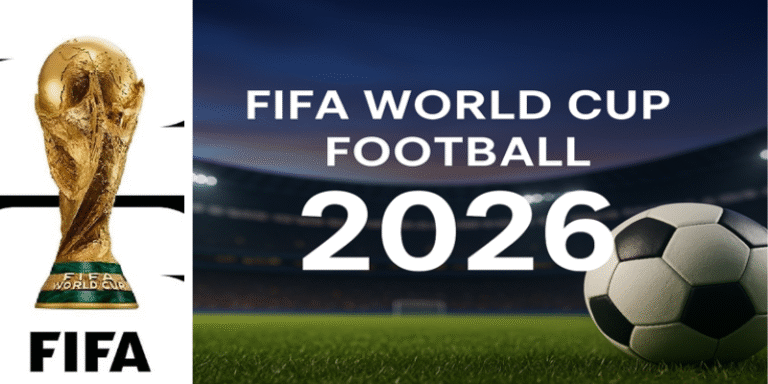The FIFA World Cup Football 2026 will be historic for multiple reasons: it will be the first to feature 48 teams and the first to be co-hosted by three nations—Canada, the United States, and Mexico. Scheduled from 11 June to 19 July 2026, this tournament reflects FIFA’s ambition to broaden global participation and commercial reach (FIFA, 2023).
1.0 Tournament Format and Host Cities
1.1 New Competition Structure
The expansion from 32 to 48 teams will introduce a new format of 12 groups of four, eliminating the previous plan of 16 groups of three due to concerns over match-fixing and competitiveness (FourFourTwo, 2023). The top two teams from each group, along with the eight best third-placed teams, will progress to a Round of 32, increasing total matches to 104 (FIFA, 2023).
1.2 Geographical Spread
Sixteen host cities have been announced:
- Canada: Toronto, Vancouver
- Mexico: Mexico City, Monterrey, Guadalajara
- USA: 11 cities including New York/New Jersey, Los Angeles, Dallas, and Atlanta (Wikipedia, 2024).
Mexico City’s Estadio Azteca will make history by becoming the first stadium to host three men’s World Cup tournaments (Wikipedia, 2024).
2.0 Economic and Social Impact
2.1 Macro-Economic Effects
According to an economic impact report commissioned by FIFA, the 2026 World Cup is projected to add USD 40.9 billion to global GDP and create over 800,000 jobs worldwide, with 185,000 in the United States alone (OpenEconomics, 2023). For example, Los Angeles County expects to generate USD 594 million in economic impact, including USD 343 million in direct spending (Micronomics, 2024).
2.2 Host-City Legacy
Host cities anticipate long-term benefits such as improved transport, tourism, and international exposure. Los Angeles expects over USD 230 million in global media value through brand exposure and visitor engagement (Micronomics, 2024). Academic studies support the idea that such events can enhance urban development and international prestige if managed effectively (Preuss, 2019).
3.0 Sporting and Logistical Considerations
3.1 Athlete Welfare and Venue Preparedness
Concerns have been raised about playing conditions, particularly at stadiums like MetLife in New Jersey, which uses artificial turf. Temporary natural grass may be installed, but players like Reece James have expressed unease about injury risks (TalkSport, 2024). FIFA will need to ensure all venues meet elite playing standards.
3.2 Climate Risks
With the tournament held in summer, some cities face high temperatures. A report identified at least six host cities as being at moderate to high risk of heat stress, raising player safety issues (Associated Press, 2024). FIFA is likely to consider hydration breaks and match rescheduling similar to the Qatar 2022 adaptations.
4.0 Political and Cultural Dimensions
The tournament also plays a geopolitical role. Former US President Donald Trump supported the joint North American bid, and analysts suggest the event could be used to project American soft power (The Times, 2024). Some critics argue that the selection of hosts was driven more by commercial viability than football passion, as evidenced by Morocco’s unsuccessful bid (Britannica, 2024).
5.0 Competitive Balance and Tournament Theory
5.1 Dead Rubbers and Format Critique
Research warns that a 48-team structure could lead to more non-competitive, “stakeless” matches. Csató and Gyimesi (2025) propose mathematically optimised group structures to maintain competitiveness and viewer engagement.
5.2 Alternative Formats
Rennó-Costa (2023) advocates a double-elimination format as a more balanced and fair approach. His analysis suggests this model could provide better outcomes within the same tournament timeframe, avoiding predictable early exits.
6.0 Economic Costs vs Legacy Gains
While the economic potential is vast, previous tournaments offer mixed legacy outcomes. Some host nations, such as Germany (2006), saw long-term benefits, while others like Brazil (2014) and South Africa (2010) struggled with post-tournament debt and unused infrastructure (Zimbalist, 2018). The challenge lies in leveraging temporary events for lasting gains (IJNRD, 2022).
7.0 Global Reach and Broadcasting
With broadcasting deals across five continents, FIFA expects a record global audience. In the UK, BBC and ITV will share coverage, while Fox Sports and Telemundo will air matches in the US (ESPN, 2024). Broadcasters anticipate high advertising revenue and record viewer numbers.
8.0 Fan Experience and Infrastructure
Organisers estimate 6.5 million fans will attend in person, with several cities planning major infrastructure upgrades, including expanded public transit and fan zones (FIFA, 2023). Entertainment experiences, including a proposed Coldplay performance during the final, are designed to create a “Super Bowl-style” atmosphere (Time Magazine, 2025).
The 2026 FIFA World Cup represents a significant evolution for the tournament. Its expanded format, global hosting model, and economic potential signal a bold new chapter in football. However, logistical, climatic, and financial challenges must be addressed to ensure lasting benefits. Success will depend not just on what happens on the pitch, but on how well host nations balance legacy goals with responsible event management.
References
Associated Press (2024) How climate change could force FIFA to rethink World Cup kickoff times. Available at: https://apnews.com/article/99e16d6f504224c27bbe659dd881c284.
Britannica (2024) 2026 FIFA World Cup. Available at: https://www.britannica.com/event/2026-FIFA-World-Cup.
Csató, L. and Gyimesi, A. (2025) ‘Increasing competitiveness by imbalanced groups: The example of the 48-team FIFA World Cup’, arXiv preprint. Available at: https://arxiv.org/abs/2502.08565.
ESPN (2024) All you need to know one year out from the 2026 World Cup. Available at: https://www.espn.com/football/story/_/id/40014470/world-cup-2026-everything-need-know.
FIFA (2023) FIFA World Cup 2026™ – New format approved by FIFA Council. Available at: https://www.fifa.com.
FourFourTwo (2023) World Cup 2026 format explained. Available at: https://www.fourfourtwo.com/features/world-cup-2026-format-explained.
IJNRD (2022) ‘How does hosting the FIFA World Cup economically impact the host country?’, International Journal of Novel Research and Development, 7(7), pp. 324–330.
Micronomics (2024) Economic Impact of FIFA World Cup 2026 in Los Angeles County. Available at: https://static1.squarespace.com/static/61b53e492ea58d13b806ccb3/t/668c5701d897eb08bf8a2355/1720473346077.
OpenEconomics (2023) FIFA World Cup 2026 Economic Forecast. Commissioned by FIFA.
Preuss, H. (2019) Event Legacy and Mega Events: Social and Economic Perspectives. London: Routledge.
Rennó-Costa, C. (2023) ‘A double-elimination format for a 48-team FIFA World Cup’, arXiv preprint. Available at: https://arxiv.org/abs/2301.03411.
TalkSport (2024) Reece James raises concerns about 2026 World Cup pitches. Available at: https://talksport.com.
The Times (2024) Trump’s influence on US World Cup bid. Available at: https://www.thetimes.co.uk.
Time Magazine (2025) Everything You Need to Know About the 2026 World Cup. Available at: https://time.com.
Wikipedia (2024) 2026 FIFA World Cup. Available at: https://en.wikipedia.org/wiki/2026_FIFA_World_Cup.
Zimbalist, A. (2018) ‘Is it worth it? Hosting mega sporting events’, Digital Showcase, University of Lynchburg. Available at: https://digitalshowcase.lynchburg.edu.









